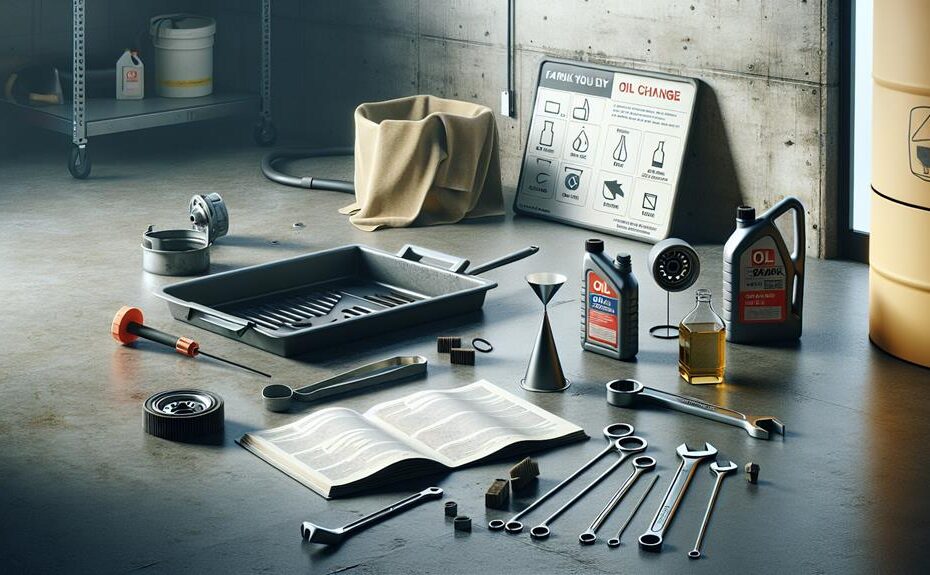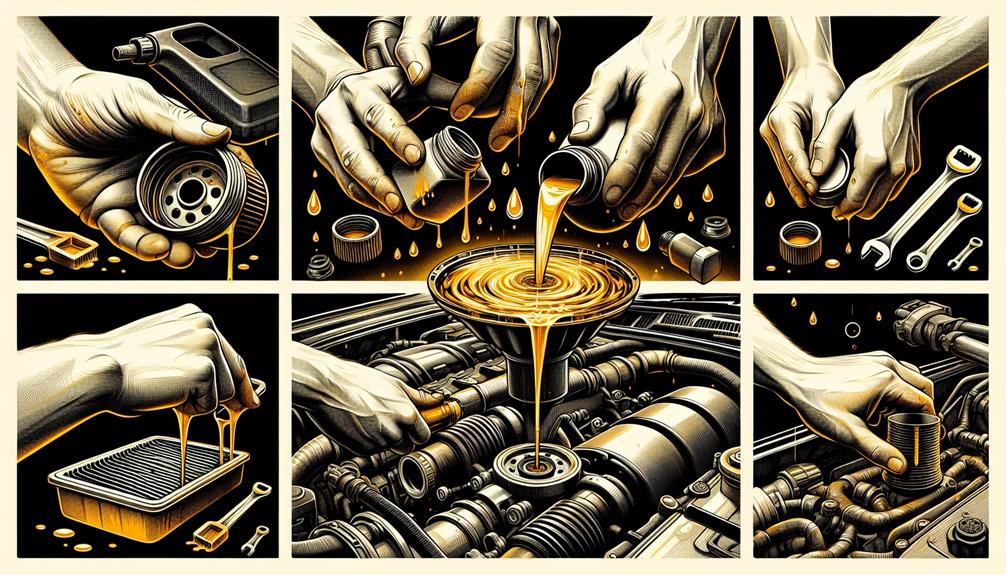You consider yourself a beginner when it comes to car maintenance, but you also value efficiency and want to save some money.
Well, look no further because in this discussion, you will discover some efficient DIY car oil change tips that are perfect for beginners like yourself.
These tips will not only help you save time and effort, but also ensure that your car's engine remains in top condition.
So, if you're ready to learn how to perform a successful oil change on your own, then let's get started!
Key Takeaways
- Always refer to the car's manual for the correct oil viscosity and specifications.
- Follow proper safety precautions, such as wearing protective gloves and goggles, parking the car on a level surface, and letting the engine cool down.
- Dispose of the old oil properly by transferring it into a sealable container and taking it to a local recycling center or auto parts store.
- When changing the oil filter, use the appropriate tools, such as a filter wrench, and remember to inspect the gasket on the old filter and apply a thin layer of oil to the new filter's gasket.
Gathering the Necessary Tools
To successfully complete a DIY car oil change, you'll need to gather a specific set of tools. Choosing the right type of oil is crucial for the smooth functioning of your vehicle's engine. Before starting the oil change process, make sure to refer to your car's manual to determine the correct oil viscosity and specifications. This will ensure optimal performance and prevent any potential damage to your engine.
Safety precautions during an oil change are of utmost importance. First and foremost, ensure that your vehicle is parked on a level surface and the engine is cool. This will prevent any accidents or injuries. Additionally, remember to wear protective gloves and goggles to shield yourself from any potential oil spills or splatters.
Now, let's discuss the necessary tools for a DIY car oil change. You'll need an oil filter wrench to remove the old filter and a socket wrench to loosen the drain plug. A drain pan is essential to catch the old oil as it drains out. A funnel will help you pour the new oil into the engine without any spills. Don't forget to have a rag or paper towels handy to wipe any oil spills or drips.
Preparing the Car for an Oil Change
Before you start preparing your car for an oil change, gather all the necessary tools mentioned in the previous section to ensure a smooth and efficient process. Once you have the tools ready, there are a few precautions you should take before starting the oil change.
First, make sure your car is parked on a level surface to prevent it from rolling or tipping over. This will ensure your safety throughout the process.
Additionally, it's important to let the engine cool down before you begin. Hot oil can cause burns, so give it some time to cool off before proceeding.
Another precaution to take is wearing protective gloves. Oil can be messy and can contain harmful chemicals, so wearing gloves will protect your hands from any potential skin irritation or burns. Nitrile gloves are recommended, as they're resistant to oil and other chemicals. Make sure to choose gloves that fit properly to ensure a comfortable and secure grip while working.
Draining the Old Oil
To begin draining the old oil from your car, locate the oil drain plug underneath the engine. Follow these steps to ensure a smooth and mess-free oil change:
- Prepare the area: Place a large oil catch pan directly under the oil drain plug to catch the old oil and prevent spills. Make sure the pan is big enough to hold all the oil.
- Loosen the drain plug: Use a wrench to loosen the drain plug in a counterclockwise direction. Be careful not to drop the plug into the oil pan.
- Drain the oil: Once the plug is loose, use your fingers to remove it completely. Allow the old oil to flow out completely into the catch pan. Be patient and let the oil drain fully before moving on to the next step.
- Dispose of the old oil properly: After the old oil has been drained, transfer it into a sealable container. Take this container to a local recycling center or an auto parts store that accepts used oil. Never pour the oil down the drain or throw it in the trash, as it's harmful to the environment.
Changing the Oil Filter
Now, let's move on to the important task of changing the oil filter in your car. Changing the oil filter is an essential part of a complete oil change as it helps to remove any contaminants from the engine oil. Before you begin, make sure to gather all the necessary tools such as a filter wrench, new filter, and a drain pan.
To start, locate the oil filter, which is typically located near the engine block. Use caution when removing the old filter as it may still contain hot oil. Place the drain pan underneath the filter to catch any residual oil that may drip out. Using a filter wrench, loosen the old filter by turning it counterclockwise. Once loose, carefully remove the old filter by hand.
Before installing the new filter, take a moment to inspect the gasket on the old filter. Ensure that it has been properly removed and isn't stuck to the engine. Apply a thin layer of oil to the gasket of the new filter to ensure a proper seal. Screw the new filter onto the engine by hand until it's snug. Then, use the filter wrench to tighten it an additional three-quarters of a turn.
After installing the new filter, it's important to double-check that it's secure and properly tightened. Start the engine and let it run for a few minutes, checking for any leaks around the filter. If you notice any leaks, immediately turn off the engine and troubleshoot the issue. Common troubleshooting tips include checking the gasket, ensuring the filter is properly tightened, or replacing the filter altogether if necessary.
Changing the oil filter is a crucial step in maintaining the health and performance of your car's engine. By following these cautionary steps and troubleshooting tips, you can ensure a successful oil filter replacement during your DIY oil change.
Refilling With New Oil
Now that you have successfully changed the oil filter in your car, it's time to move on to the next important step: refilling with new oil. Follow these steps to ensure a proper oil refill:
- Proper disposal of old oil: Before refilling with new oil, it's crucial to dispose of the old oil properly. Check with your local recycling center or auto parts store for guidelines on how to dispose of used oil safely and responsibly.
- Choosing the right oil for your car's engine: Refer to your car's owner manual to determine the correct oil viscosity and type recommended for your specific engine. This information is usually found in the maintenance section of the manual. Selecting the right oil is essential for optimal engine performance and longevity.
- Locate the oil filler cap: Open the hood of your car and locate the oil filler cap. It's usually labeled and can be found on top of the engine. Remove the cap to access the oil reservoir.
- Pour in the new oil: Using a funnel, slowly pour the new oil into the oil reservoir. Be sure to pour it in gradually to prevent spills or overfilling. Check the dipstick periodically to ensure you have added the correct amount of oil.
Frequently Asked Questions
How Often Should I Change My Car's Oil?
You should change your car's oil every 3,000 to 5,000 miles, depending on the manufacturer's recommendations. To know if your car needs an oil change, check the oil level and color. Dispose of used oil properly by taking it to a recycling center.
Can I Use Any Type of Oil for My Car's Oil Change?
You can't use any type of oil for your car's oil change. Different car models require different types of oil. Synthetic oil has pros and cons, such as better performance but higher cost.
Is It Necessary to Replace the Oil Filter Every Time I Change the Oil?
Yes, it is necessary to replace the oil filter every time you change the oil. This ensures that any contaminants or debris are properly removed, allowing your engine to run smoothly and efficiently.
What Happens if I Accidentally Overfill the Engine With New Oil?
If you accidentally overfill the engine with new oil, it can lead to serious damage. The excess oil can cause foaming, which decreases lubrication and can damage engine components. To fix it, drain the excess oil and refill with the correct amount.
Can I Reuse the Drain Plug Gasket When Changing the Oil?
Yes, you can reuse the drain plug gasket when changing the oil, but it is recommended to replace it for a proper seal. Make sure you have the necessary oil change tools and equipment for a successful DIY.
Conclusion
In conclusion, by following these efficient DIY car oil change tips for beginners, you can save time and money while ensuring the proper maintenance of your vehicle.
Remember, preparation is key, so gather all the necessary tools before starting.
Take your time to drain the old oil and change the oil filter carefully.
Finally, refill with new oil and your car will be ready to hit the road smoothly, like a well-oiled machine.



